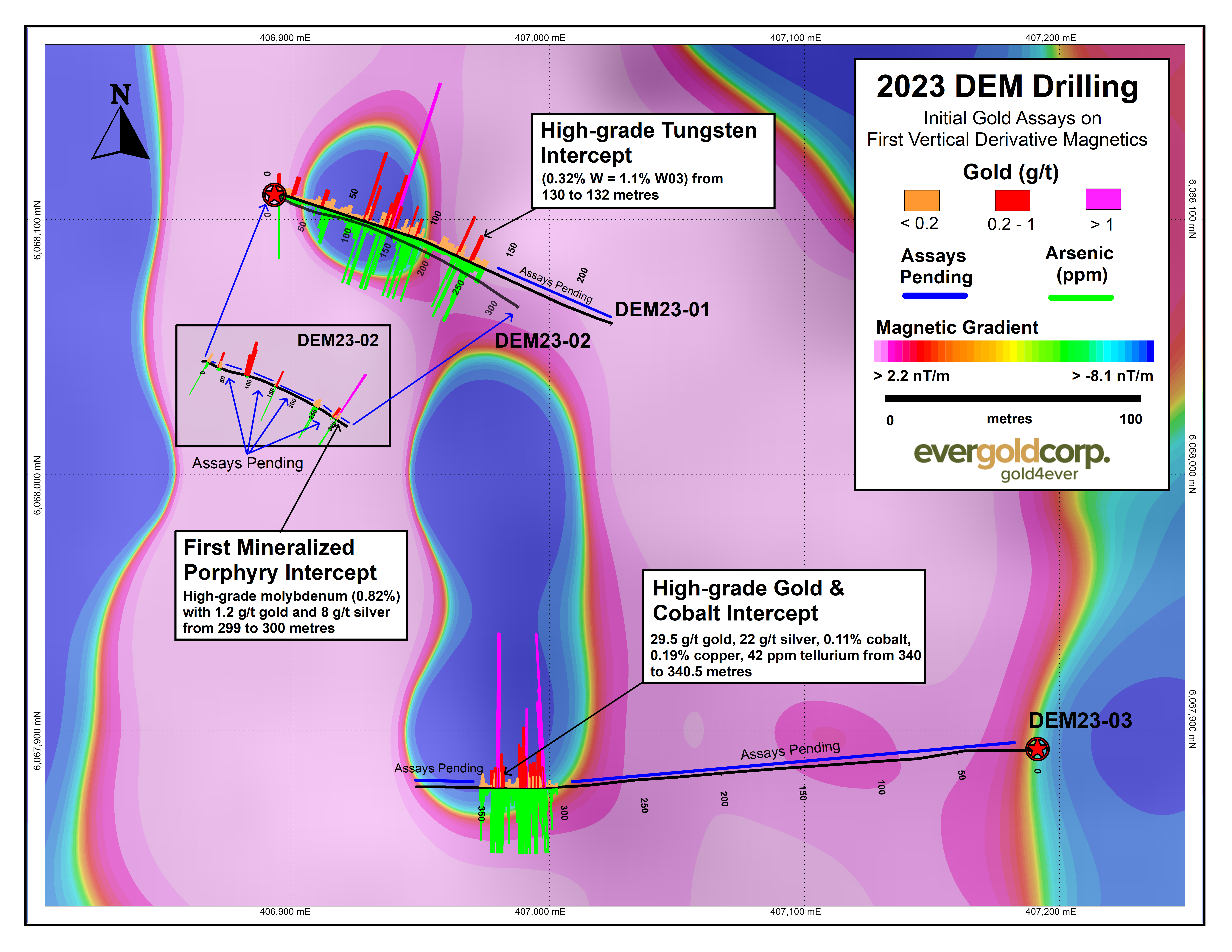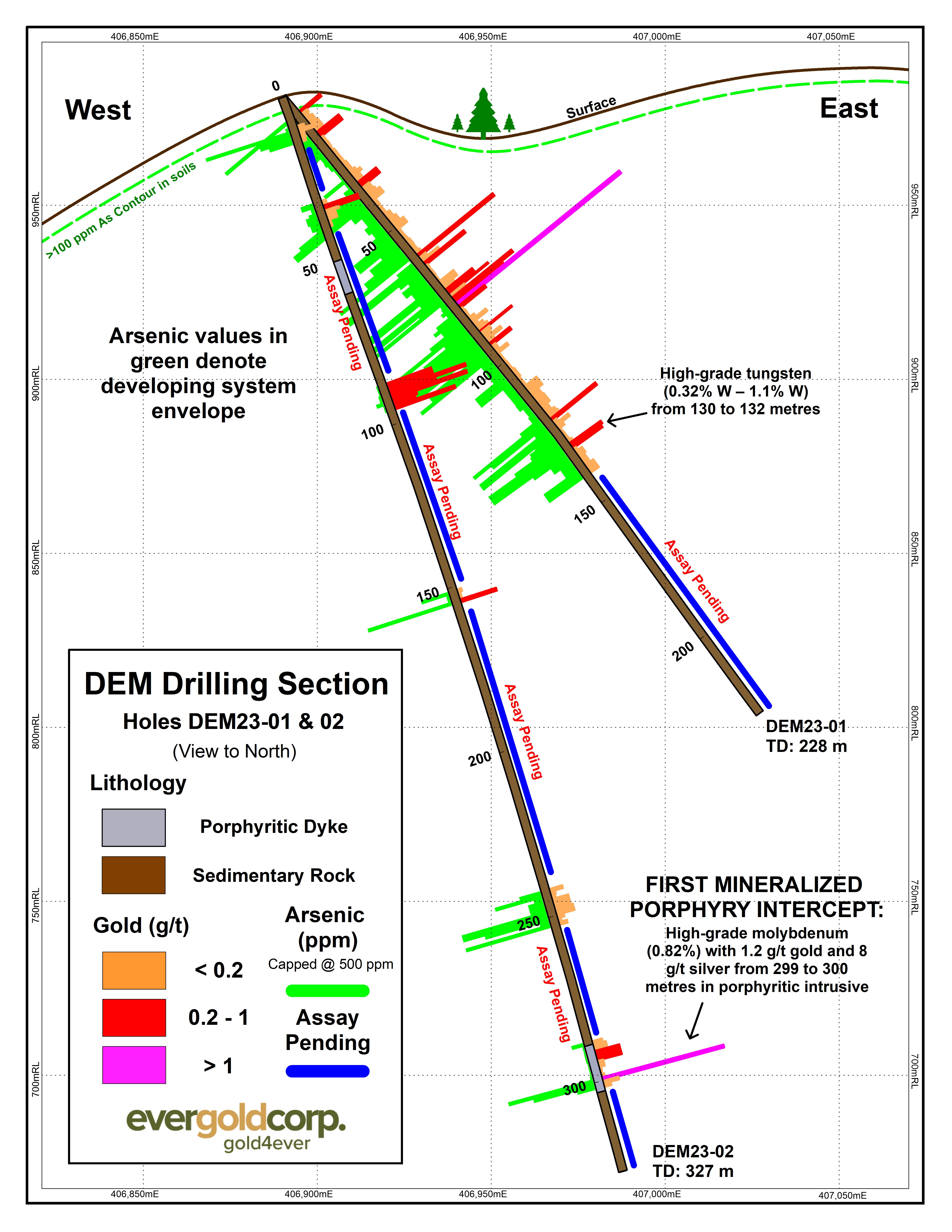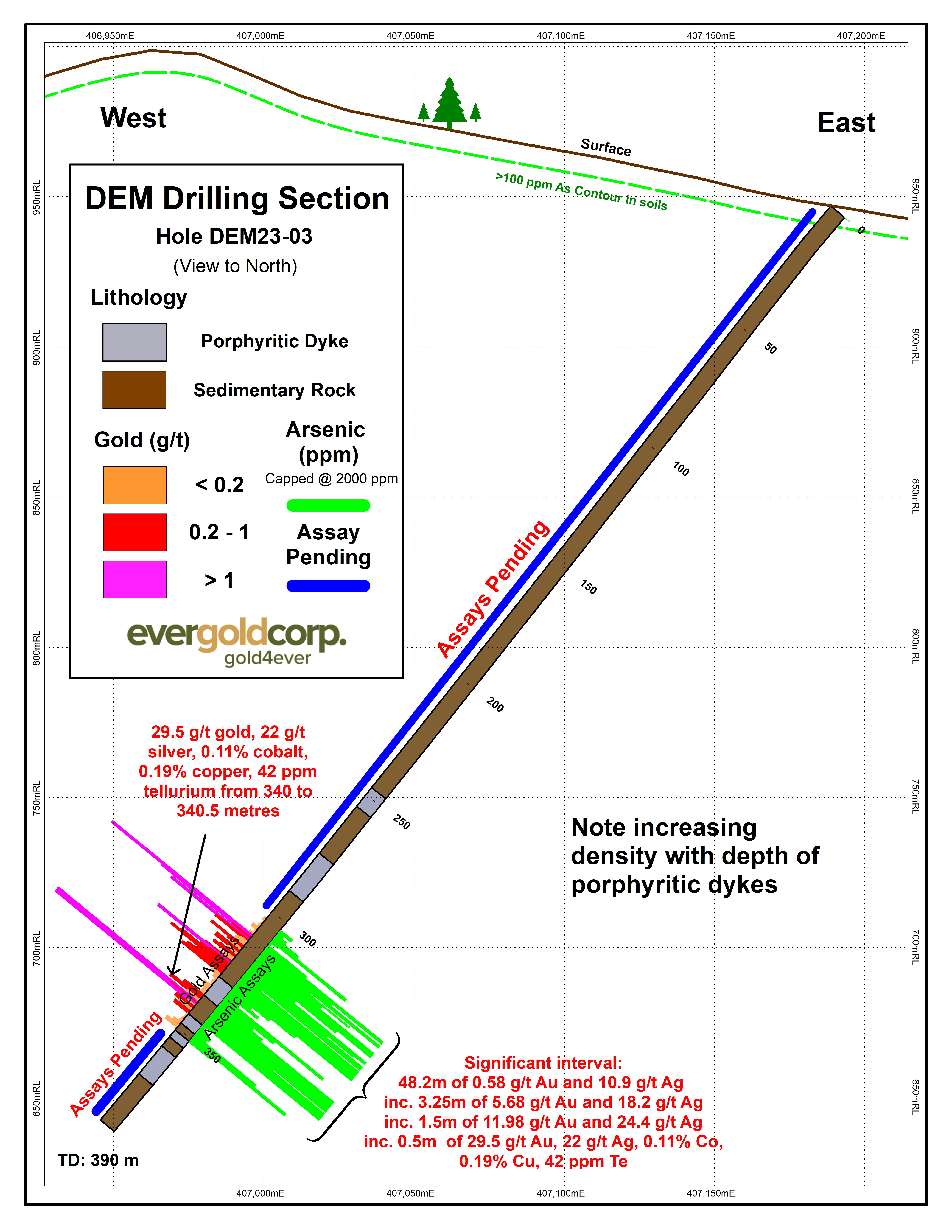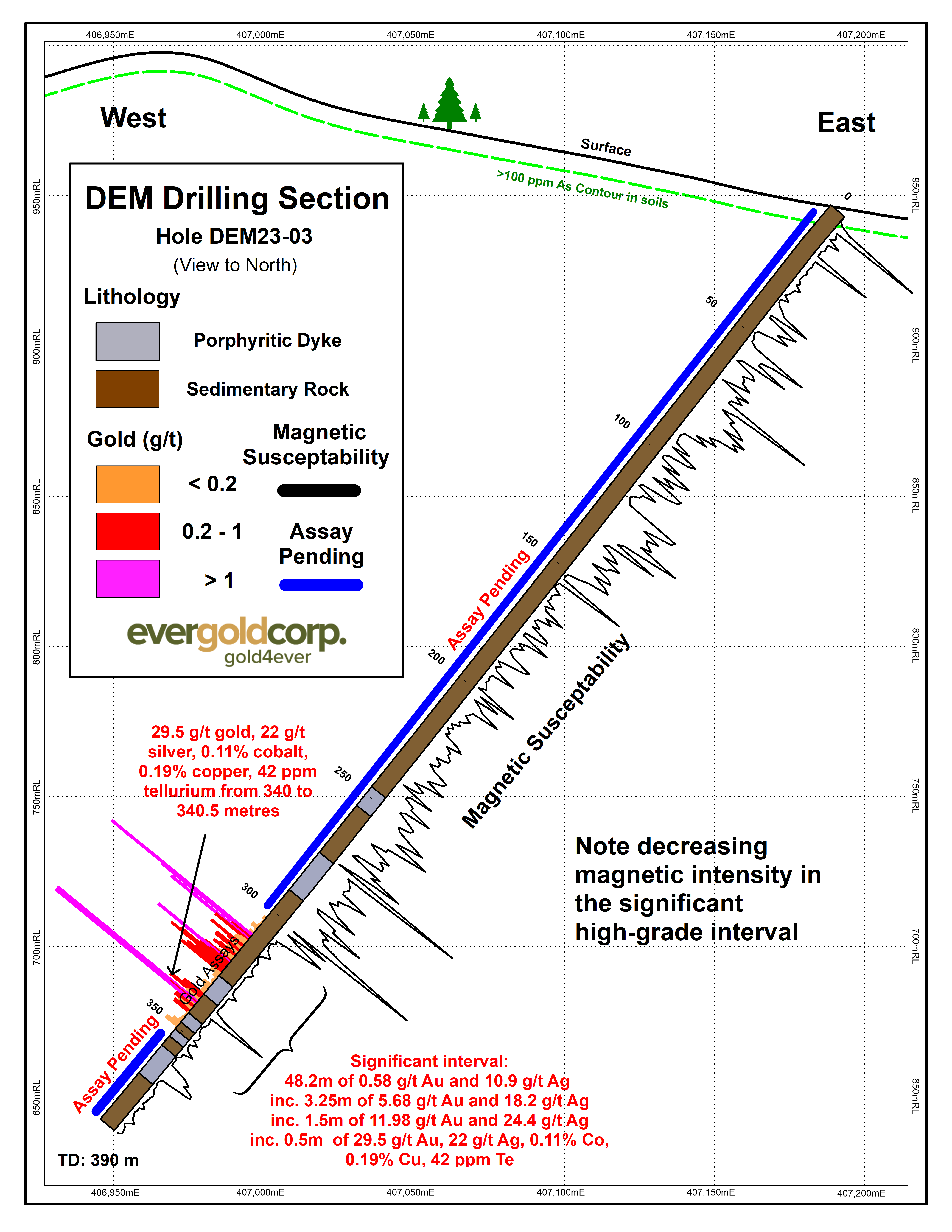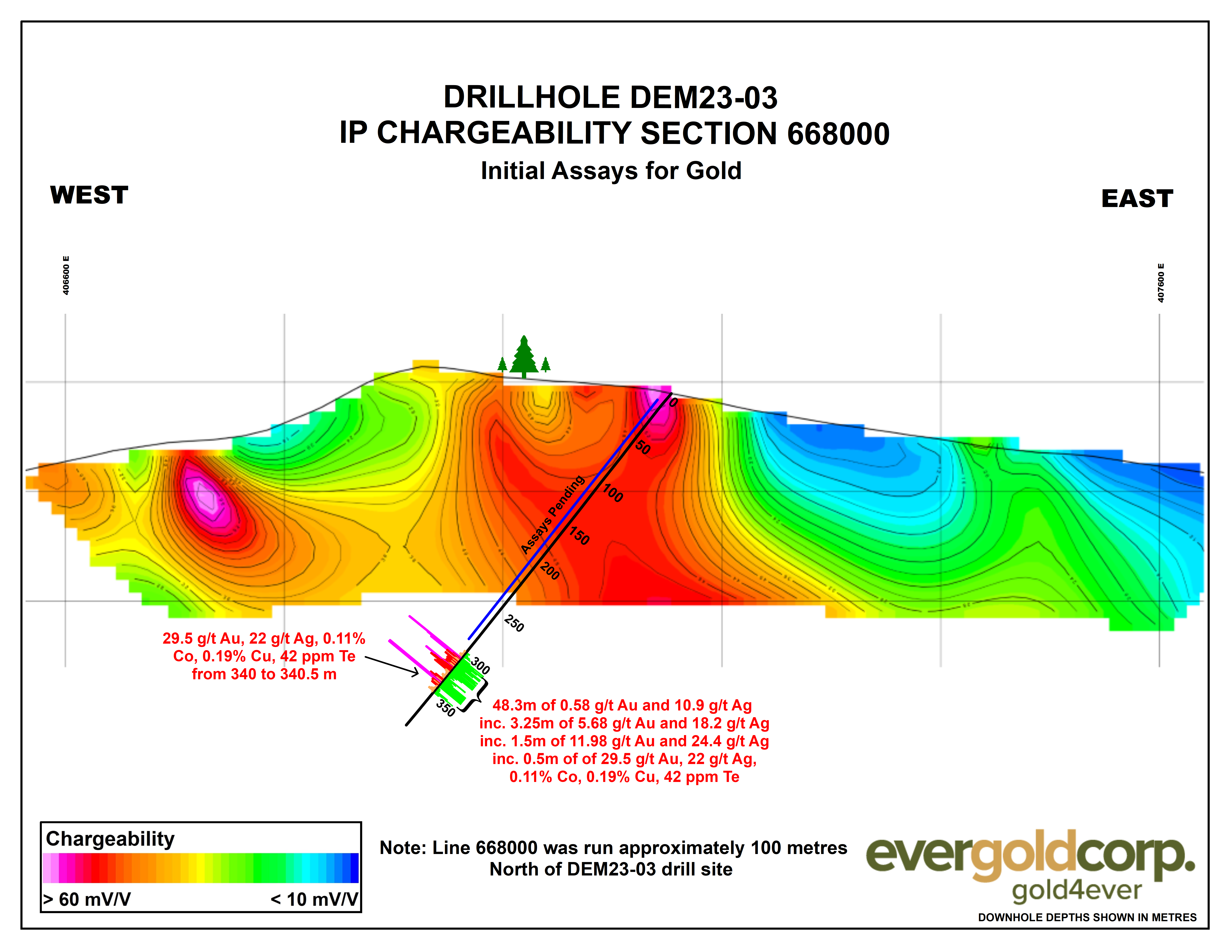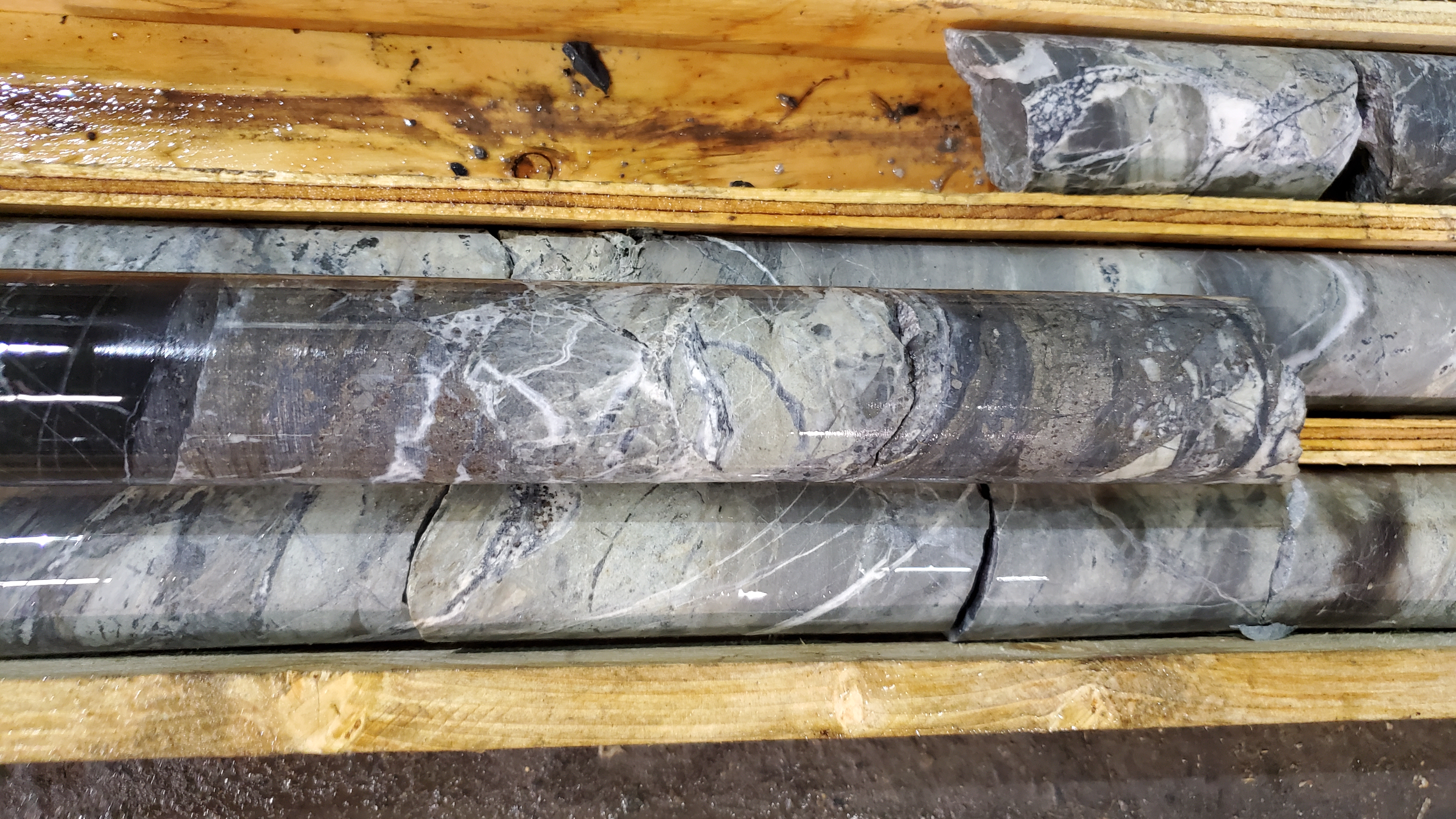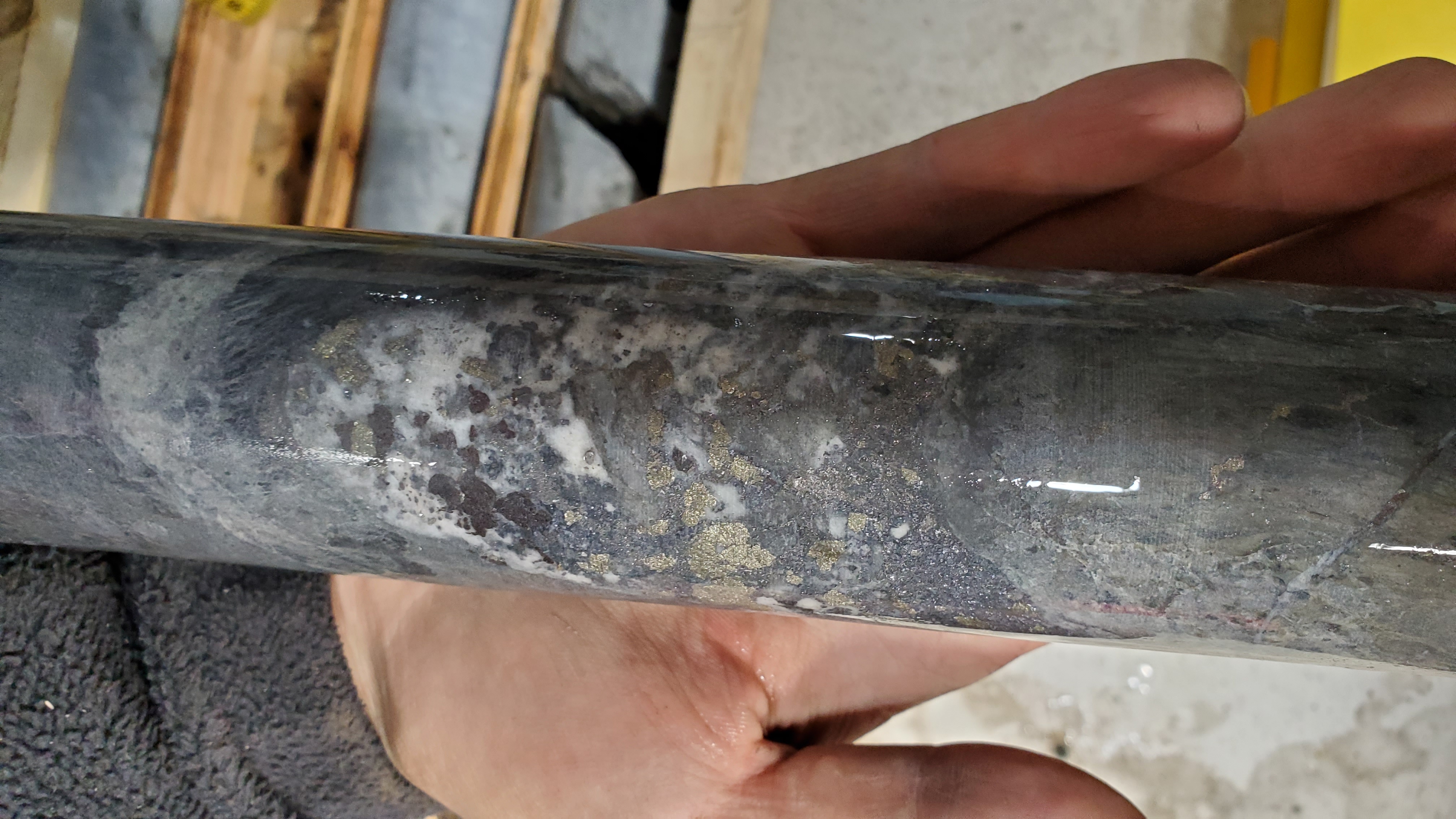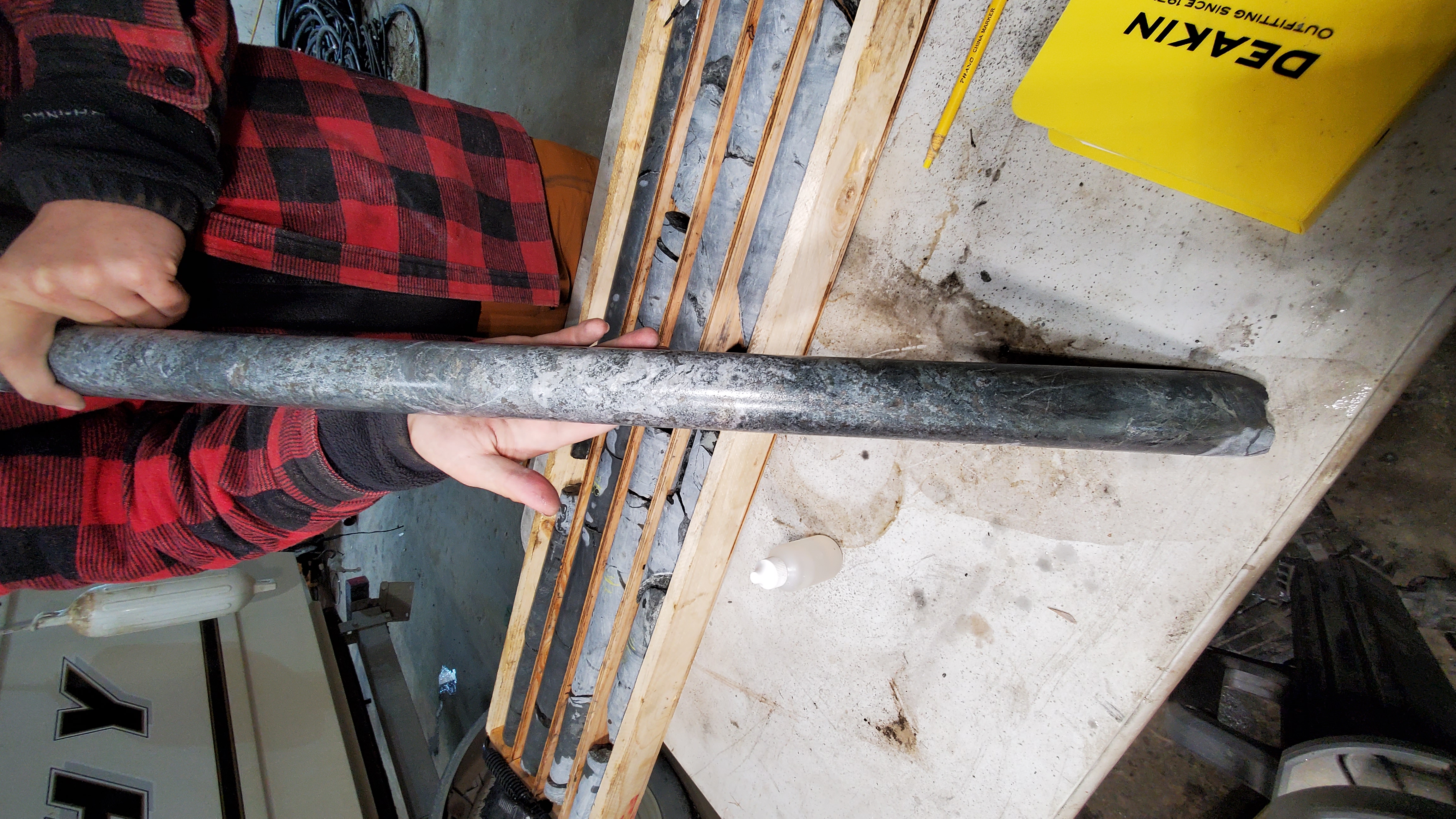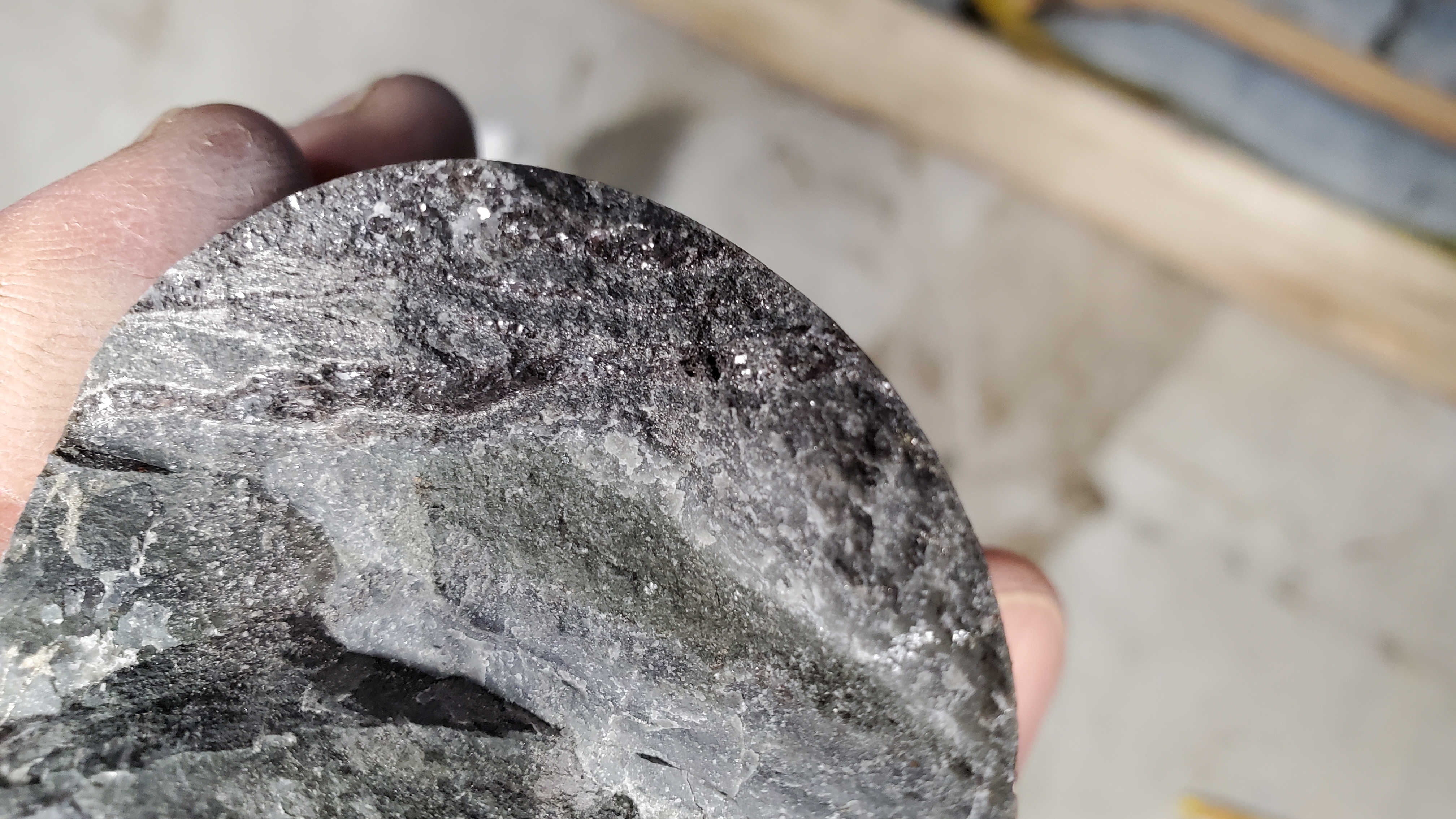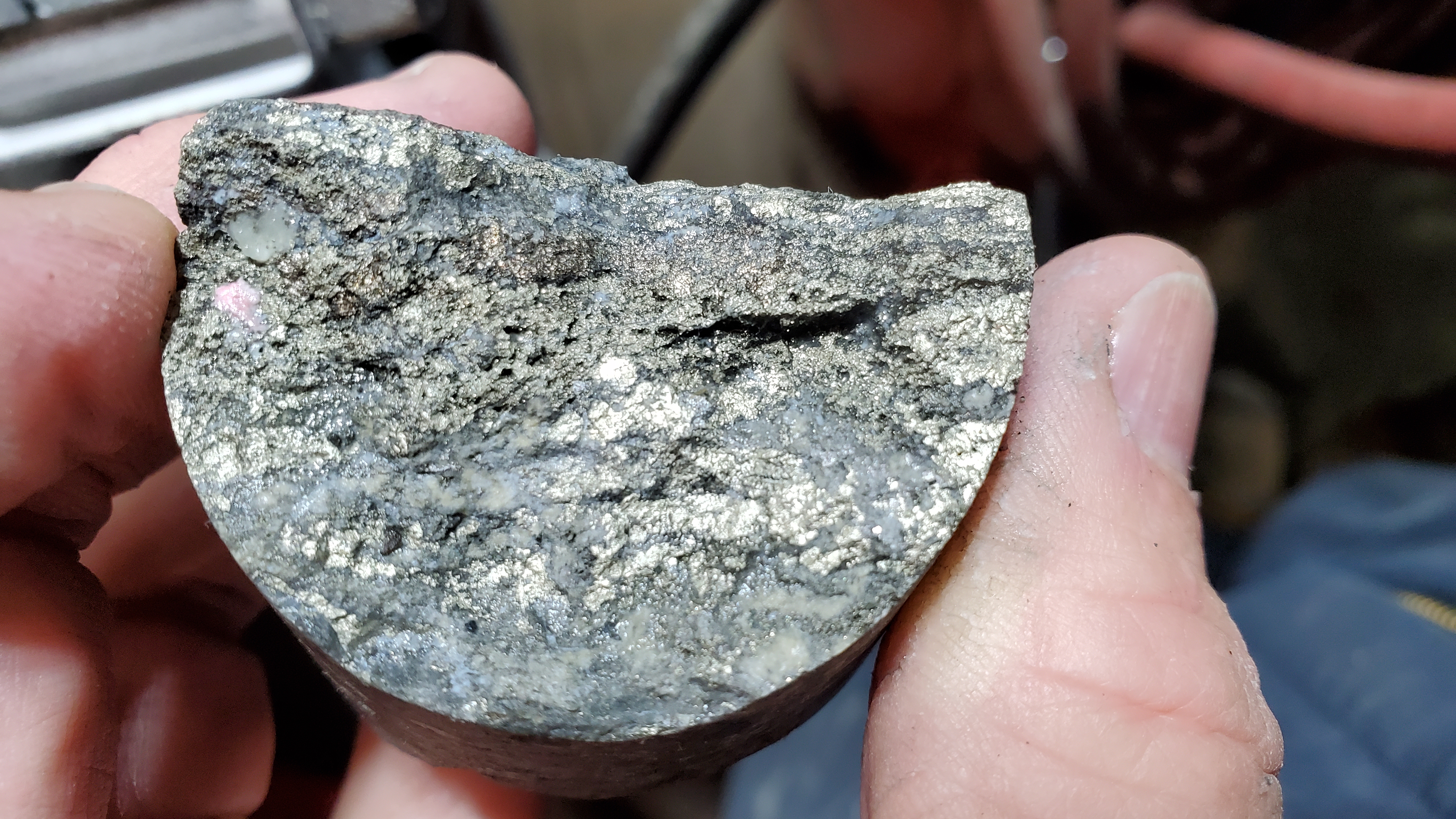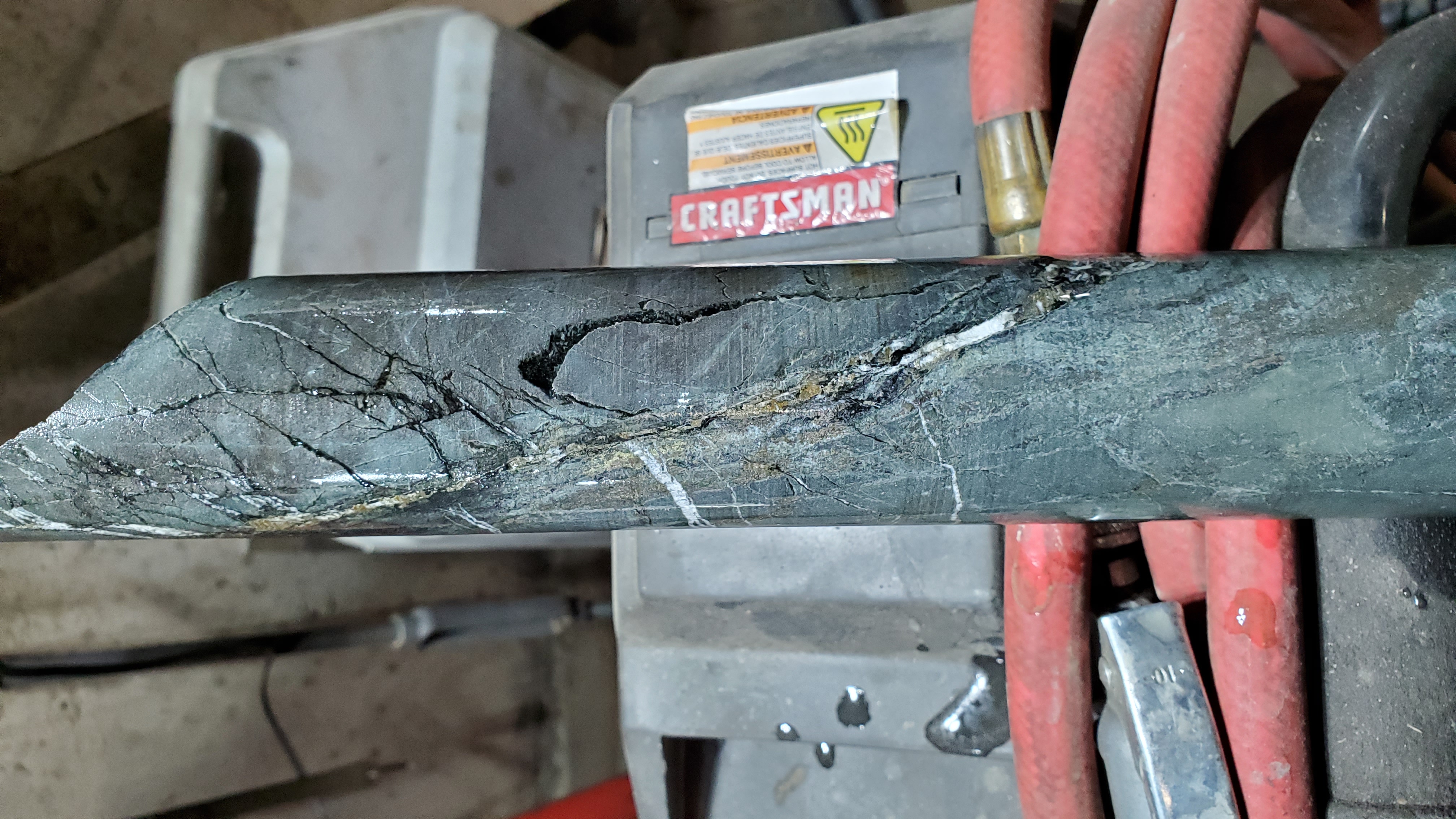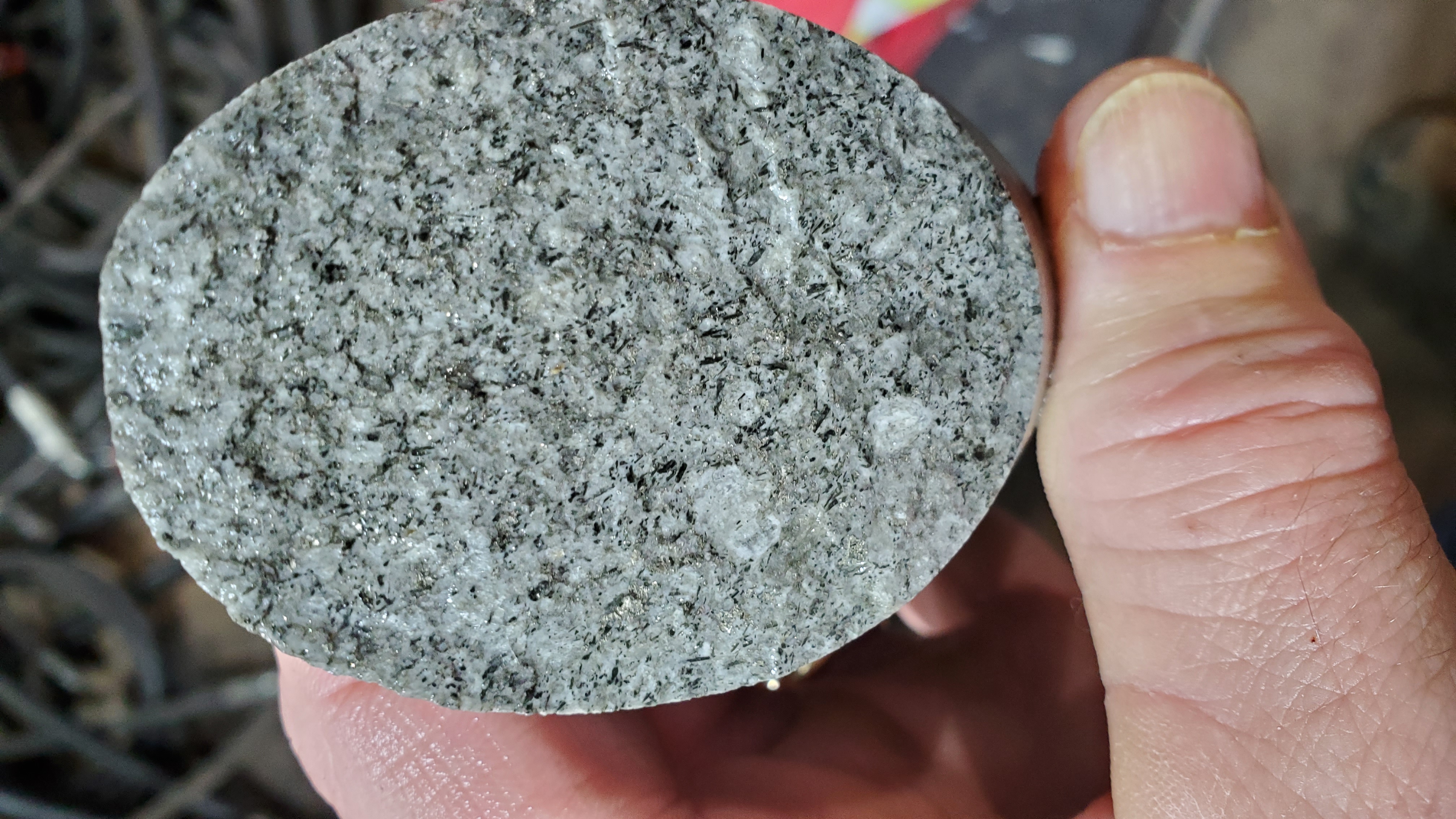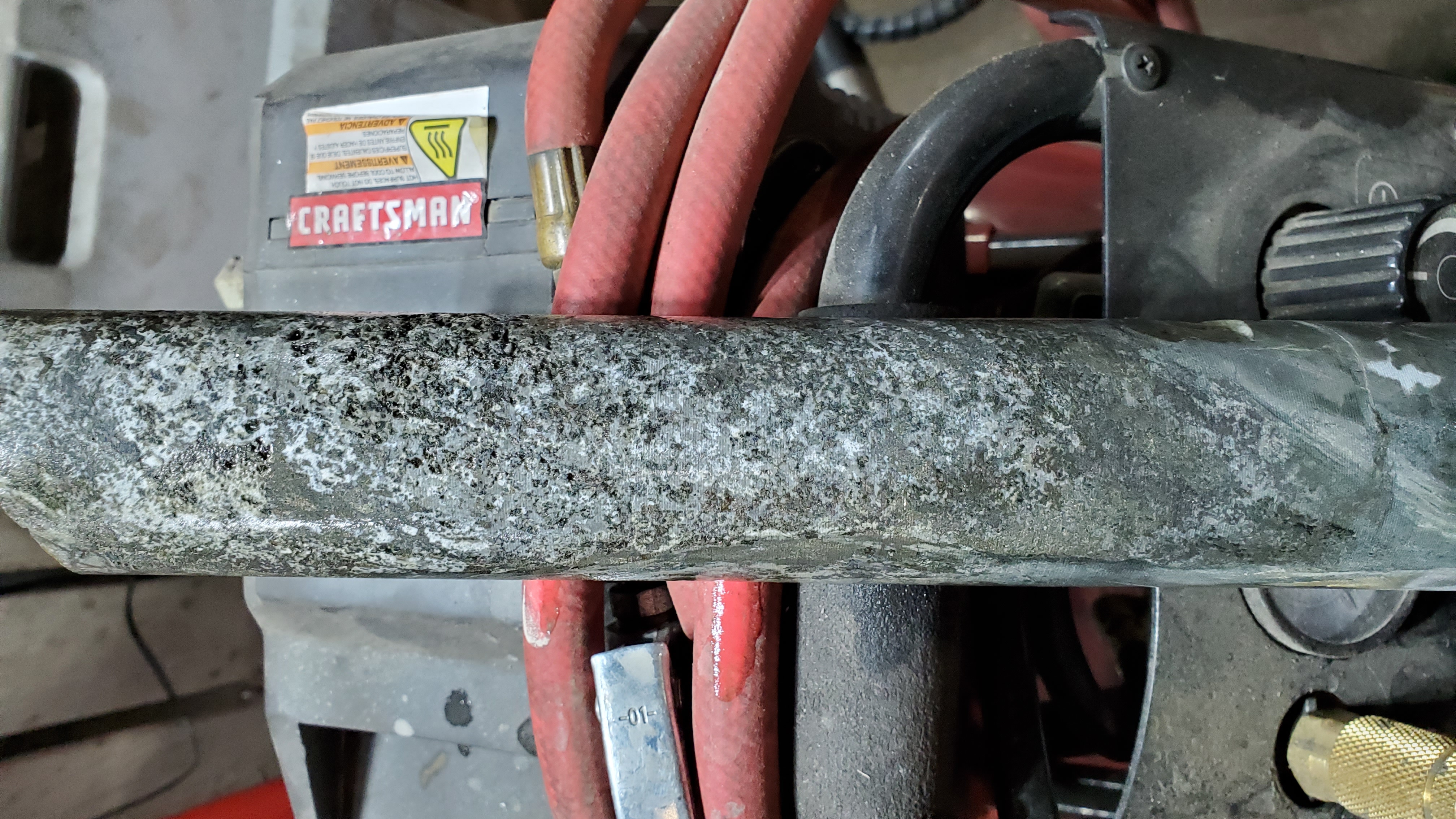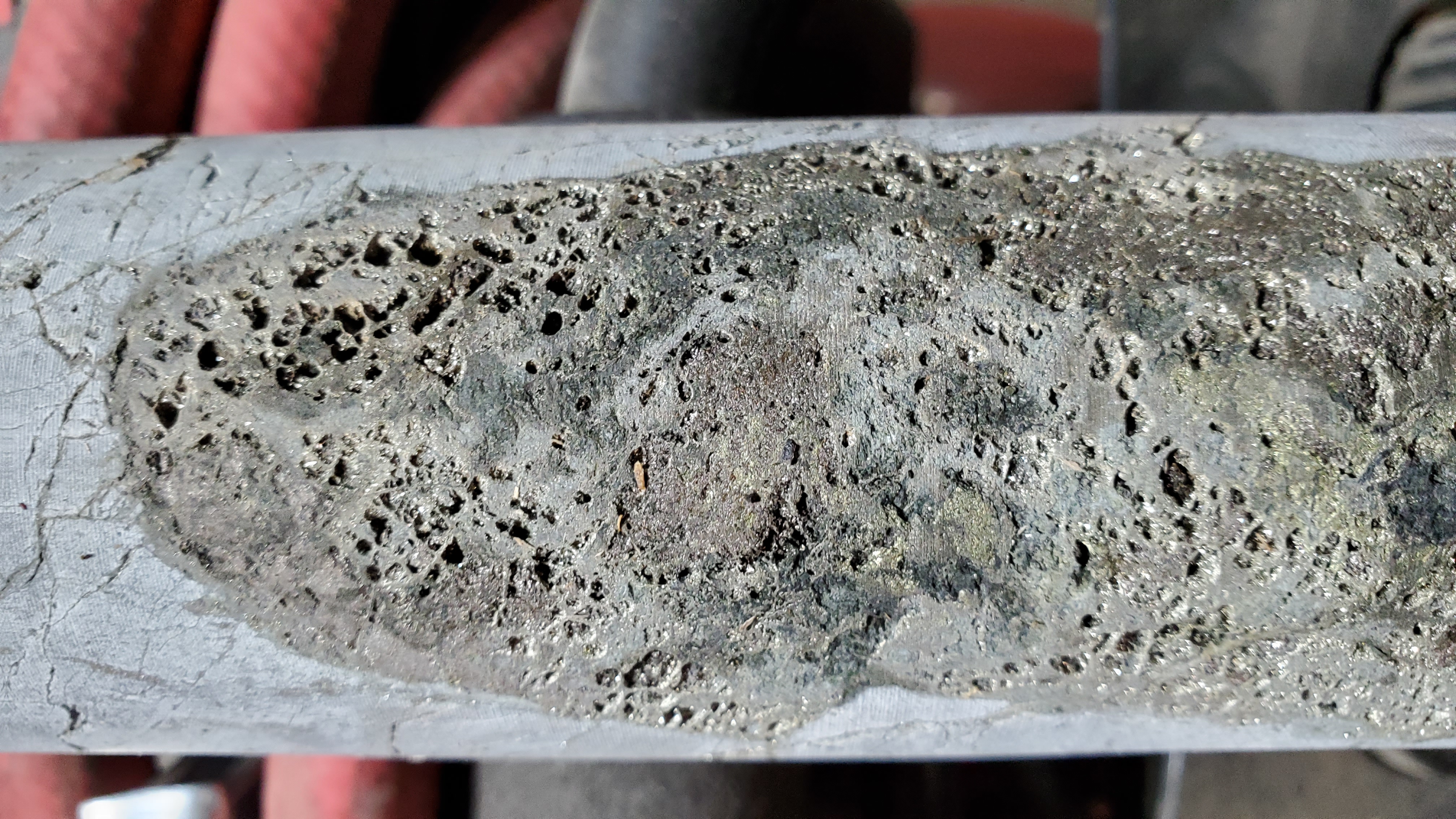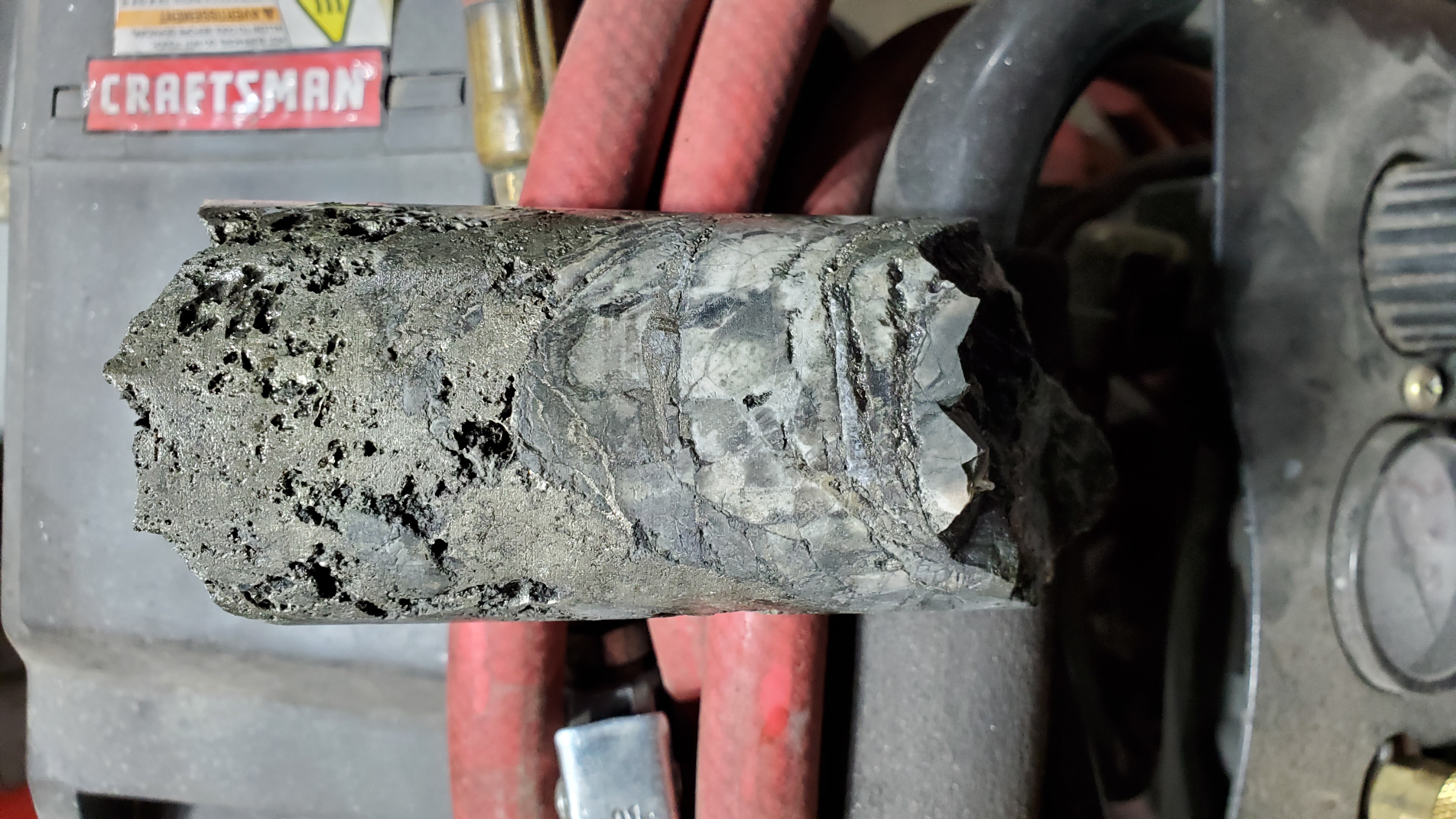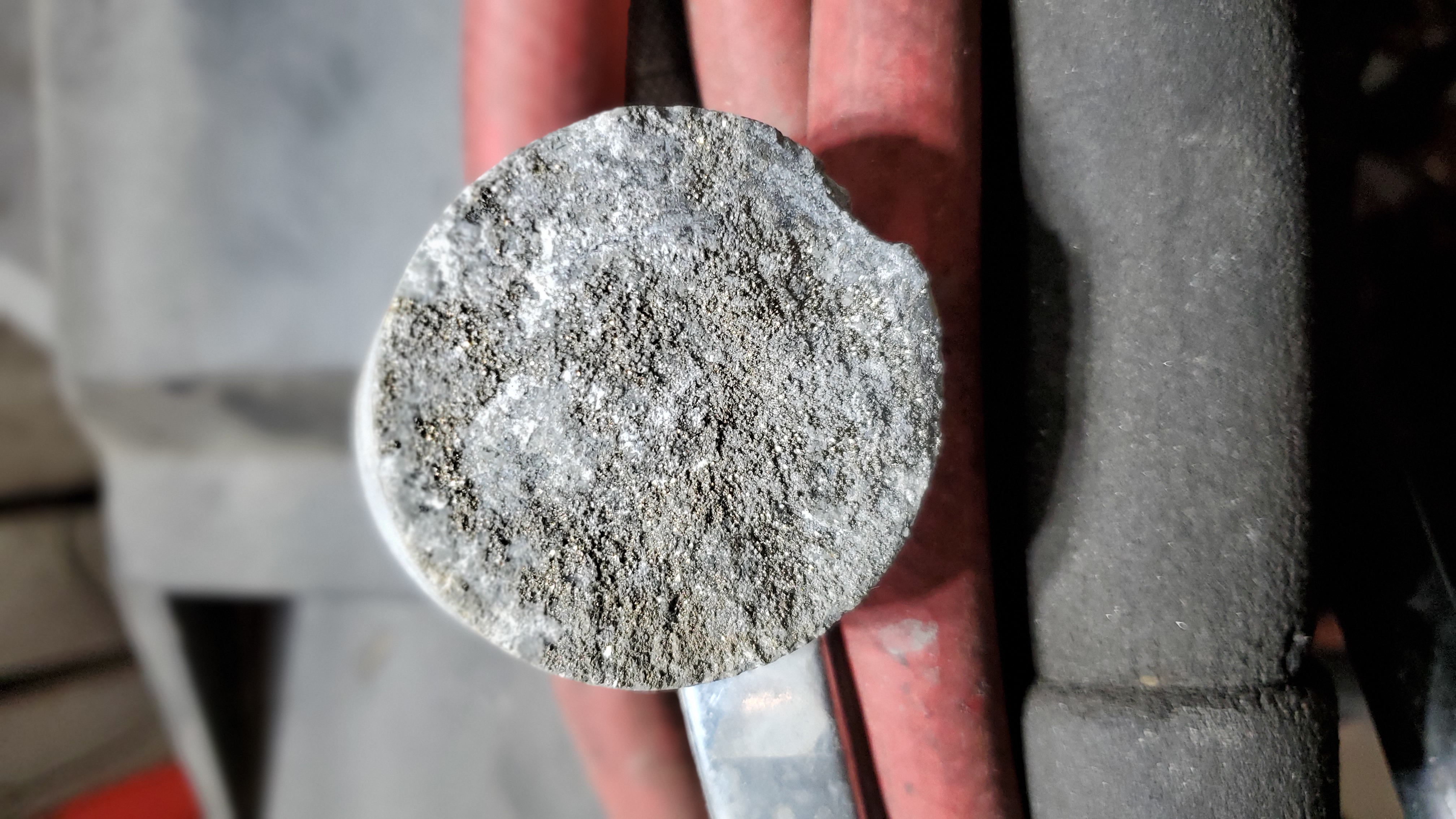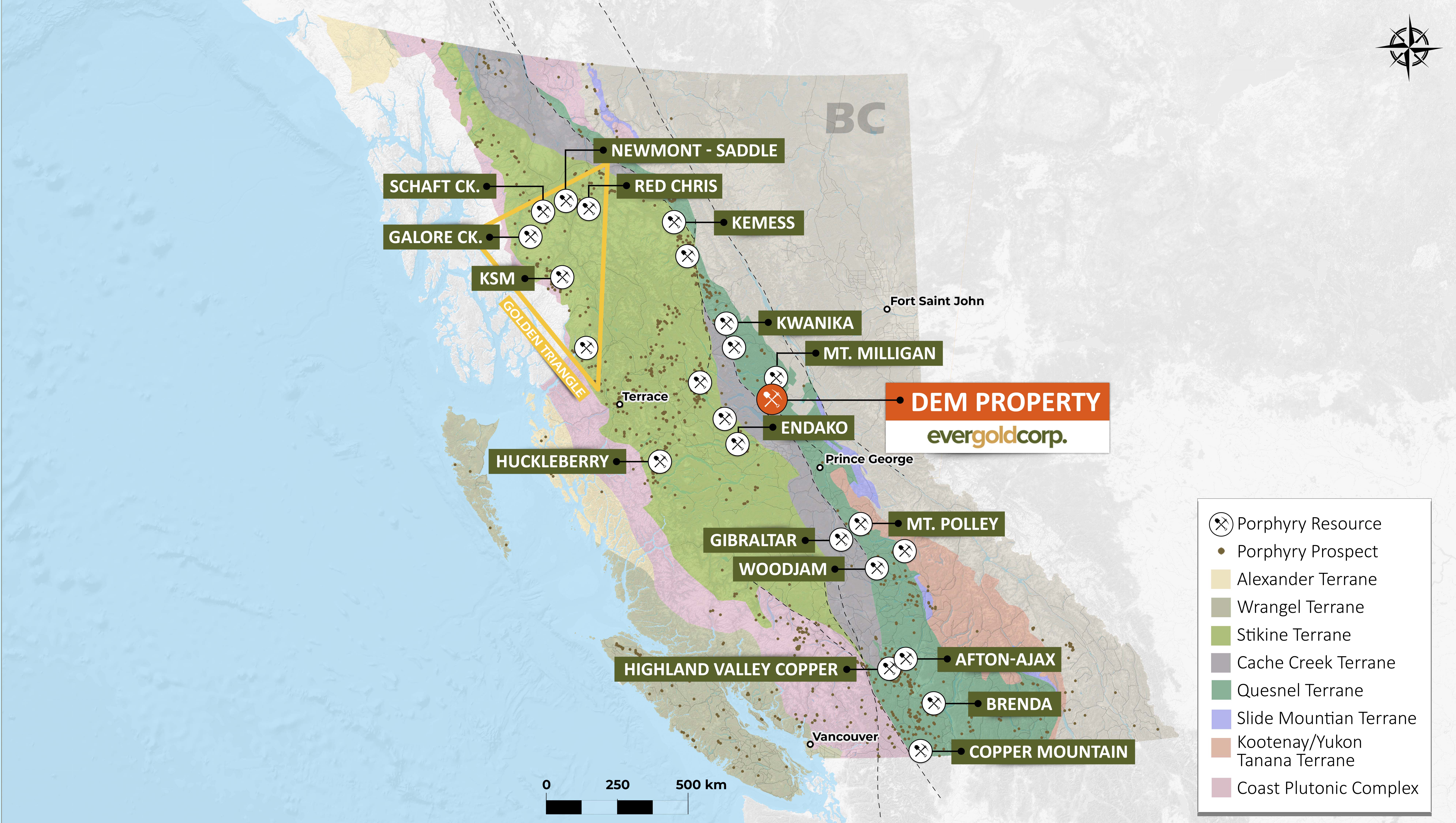TORONTO, Jan. 15, 2024 (GLOBE NEWSWIRE) -- Evergold Corp. (TSX-V: EVER, WKN: A2PTHZ) (“Evergold” or the “Company”) is pleased to report assays for initial batches of core from a small reconnaissance drill program (947 metres in 3 holes – see Figure 1 & 2 plan views) completed in late fall 2023 at the large new DEM prospect in central B.C. Assays show broad intercepts of precious metals (gold, silver) encompassing, locally, narrow intercepts of high-grade precious and, notably, high-grade / high value strategic metals (molybdenum, cobalt, tungsten), from two drill pads spaced some 400 metres apart. Additional assays are pending for all 3 holes.
The high-grade intercepts include a first porphyry-hosted intercept: high-grade (0.82% Mo) molybdenum with associated gold (1.2 g/t), rhenium (3.7 g/t) and silver-enriched (8 g/t) sulphides from veining within high-K porphyry intrusive from 299 to 301 metres in hole DEM23-02 (Figure 3). This, along with ubiquitous pyrrhotite hornfels and skarn-style assemblages, the high density of porphyritic dykes in the lower third of DEM23-03 (Figure 4), as well as induced polarization (IP) data, point to high potential for underlying and/or nearby bodies of porphyry-style mineralization. The broad gold and silver predominant intercepts are accompanied throughout the holes by strongly elevated gold pathfinder element geochemistry, particularly arsenic, antimony, bismuth and locally elevated tellurium, indicating the presence of a richly mineralized precious metals system that is considered likely to produce both broad and/or high-grade intercepts with higher-density drilling now in planning for the 2024 field season.
Reported below are partial assays for intervals in diamond core holes DEM23-01, 02 and 03. Sampling of the remainder of the holes is ongoing. Arsenic values have been determined to be the key indicator of system presence. Core photos of high-grade intercepts are included below and may also be viewed on the Company’s website at Evergold Corp. – Property Photo and Video Gallery.
Highlights:
DEM23-03: Partially delineated system envelope: 48.2 metres of 0.58 g/t Au, 11 g/t Ag and 3,696 ppm As from 303 to 351.2 metres – open in all directions. Assays of remainder of hole pending.
- Including: high-grade gold: 11.98 g/t Au, 24 g/t Ag and 71,293 ppm As from 339 to 340.5 metres
- Including: high-grade cobalt: 0.11% Co, 29.5 g/t Au, 0.19% Cu, 42 ppm Te and 35,800 As from 340 to 340.5 metres
DEM23-01: Partially delineated system envelope: 135 metres of 0.12 g/t Au, 2 g/t Ag and 901 ppm As from surface - 6 to 141 metres – open to depth. Assays of remainder of hole pending.
- Including: high-grade tungsten and high-grade silver: 0.32% W, 155 g/t Ag, 5 ppm Te, 11,850 As from 131 to 132 metres
DEM23-02: First intercept of high-grade porphyry intrusive: high-grade molybdenum (0.82%), with associated gold (1.2 g/t), silver (8 g/t), rhenium (3.7 g/t) and arsenic (2,340 ppm), from 299 to 300 metres. Assays of remainder of hole pending.
“These are very encouraging results for a first pass program, with results to date suggesting we are on the fringes of a large, and somewhat unusual, intrusion-related system,” said Kevin Keough, President & CEO. “We are genuinely excited about following up. From a very small initial program on a generally poorly-exposed and barely tested target we appear to have discovered a rich new system with many of the metals that the world is eager for these days. We’ve seen an impressive array of sulphide minerals throughout our first drill holes, high grades (locally) and broad system widths, coupled with a rather unique array of high-value elements including gold and silver, and narrow but high-grade intercepts of molybdenite with associated rhenium, as well as cobalt and tungsten, plus lesser copper, lead, zinc and locally elevated tellurium. All of this bodes well for better to come as we work this year to advance the DEM project.”
Discussion of Drill Results
Two holes (DEM23-01 & 02) were drilled due east from a first pad, and a single hole (DEM23-03) was drilled due west from a second almost 400 metres southeast (Figures 1 & 2). The holes were targeted on one prominent magnetic high. Each of the three holes intercepted a broad sulphide vein system (Figures 3 & 4 section views), hosted within variably calcareous fine-grained sedimentary rocks cut locally by metre-scale porphyritic dykes, with the host rocks, and locally the dykes, strongly infused over significant core lengths of up to 20 metres by cross-cutting sulphide-bearing veinlets and veins, locally of semi-massive to massive character, along with associated disseminated sulphides. These intervals are encompassed by broader halos of lower-intensity disseminated and sulphide-bearing veinlets and veins. Sulphide minerals observed in core include abundant disseminated and vein-hosted arsenopyrite, pyrite, and pyrrhotite, with lesser but significant sphalerite, galena, chalcopyrite, and molybdenite. Sulphosalts are also commonly observed. High-grade precious metals, cobalt and tungsten values are localized to the best developed parts of the vein system, particularly the massive sulphide sections, whereas the molybdenum, although present at elevated levels generally throughout the vein system, achieves high grades within a single narrow porphyritic intrusive (dyke) intercepted from 299 to 301 metres in DEM23-02, where it is accompanied by elevated rhenium, gold and silver and the suite of elements characterizing other parts of the DEM mineralizing system. Intriguingly, this dyke may represent an apophysis (projecting finger) off a larger body of porphyry-style mineralization nearby.
Geophysical Interpretation and Exploration Implications
Magnetic susceptibility readings taken of core and observations of core mineralogy suggest that the positive magnetic response generated over some areas of the DEM target area by an aeromagnetic survey flown in 2017 (Figure 1) is likely largely due to the magnetic properties of pyrrhotite, a common sulphide constituent of the core. Magnetic susceptibility readings taken systematically of the core down the holes also clearly demonstrate that the magnetic response has been largely destroyed in the most intensely developed, silica-rich and generally highest-grade part of the vein system as observed, for example, from 303 to 351 metres in DEM23-03 (see Figure 5). Figure 2, which shows drill hole traces with assays superimposed on the first vertical derivative (1VD) magnetics, reinforces the observation that the best precious metals mineralization may be localized along structures highlighted by magnetic gradients. If correct, this observation suggests that prominent magnetic lineaments (relative magnetic intensity lows) observed within the DEM target area (Figure 1) represent high priority exploration targets. It also highlights the fact that further magnetic surveys, both in detail over the present target area (see below), and elsewhere across the recently expanded DEM property, may prove fruitful.
In 2021, a small, 2.6 line-km induced polarization (IP) survey consisting of two east-west oriented lines separated by 200 metres was run over the general area of the recent drilling. Figure 6 shows hole DEM23-03 projected onto an image of the IP chargeability for IP line 668000, which was run approximately 100 metres north of the site of DEM23-03. Although the IP survey did not extend to the depth of the best of the DEM23-03 intercept, Figure 6 does appear to suggest that the best developed parts of the vein system (and assay values) may flank the highest chargeability.
Importantly, both the 2017 airborne magnetometer survey and the 2021 IP survey were optimized for exploration reconnaissance – not drill targeting. It is anticipated that new, detailed surveys of both will be carried out for drill targeting purposes, in-filling between existing lines, looking more deeply and broadening coverage to areas not yet surveyed.
Table 1 – Significant Initial Assay Results for Diamond Core Holes DEM23-01, 02, and 03. Note: Widths reported are drilled core lengths. True widths for the intercept in hole DEM23-03 are estimated to be greater than 95%. True widths for the intercepts in holes DEM23-01 and 02 cannot presently be determined. Core diameter is 47.6 mm (NQ). Arsenic values in core and soils have been determined to be the key indicator of system presence.
| Hole ID | From (m) | To (m) | Width (m) | Au (g/t)1 | Ag (g/t)2 | Mo (%)3 | Co (%)4 | Cu (%) | Te (ppm)2 | W (%)5 | Re (g/t) | As (ppm) | |
| DEM23-03 (additional assays pending) | |||||||||||||
| 0.00 | 303.00 | 303.00 | Assays pending | ||||||||||
| Partial System Envelope | 303.00 | 351.21 | 48.21 | 0.58 | 11 | - | - | - | - | - | - | 3,696 | |
| Including | 310.29 | 313.00 | 2.71 | 1.12 | 44 | - | - | - | - | - | - | 19,592 | |
| Including | 310.29 | 310.79 | 0.50 | 2.89 | 182 | - | - | - | - | - | - | 43,200 | |
| Including | 339.00 | 340.50 | 1.50 | 11.98 | 24 | - | 0.08 | - | 18 | - | - | 35,290 | |
| Including | 339.00 | 339.50 | 0.50 | 6.08 | 47 | - | 0.12 | - | 11 | - | - | 67,500 | |
| And Including | 340.00 | 340.50 | 0.50 | 29.50 | 22 | - | 0.11 | 0.19 | 42 | - | - | 35,800 | |
| Assays pending | 340.50 | 393.00 | 52.50 | Assays pending | |||||||||
| DEM23-01 (additional assays pending) | |||||||||||||
| Assays pending | 0.00 | 6.00 | 6.00 | Casing & rubble - assays pending | |||||||||
| Partial System Envelope | 6.00 | 141.00 | 135.00 | 0.12 | 2 | - | - | - | - | - | - | 901 | |
| Including | 60.00 | 64.00 | 4.00 | 0.42 | 1 | - | - | - | 6 | - | - | 4,689 | |
| Including | 60.00 | 61.00 | 1.00 | 0.92 | 1 | - | - | - | 16 | - | - | 10,000 | |
| And Including | 70.00 | 80.00 | 10.00 | 0.60 | 1 | - | - | - | - | - | - | 1805 | |
| Including | 76.00 | 78.00 | 2.00 | 0.65 | 2 | - | - | - | - | - | - | - | |
| And Including | 78.00 | 79.00 | 1.00 | 3.04 | 2 | - | - | 0.13 | - | - | - | 112 | |
| And Including | 87.50 | 89.00 | 1.50 | 0.20 | 48 | - | - | - | - | - | - | 5,680 | |
| And Including | 121.00 | 122.00 | 1.00 | 0.54 | 4 | - | - | - | - | - | - | 758 | |
| And Including | 130.00 | 132.00 | 2.00 | 0.35 | 82 | - | - | - | 5 | 0.16 | - | 11,575 | |
| Including | 131.00 | 132.00 | 1.00 | 0.34 | 155 | - | - | - | 7 | 0.32 | - | 11,850 | |
| Assays pending | 132.00 | 228.00 | 96.00 | Assays pending | |||||||||
| DEM23-02 (additional assays pending) | |||||||||||||
| Assays pending | 0.00 | 9.00 | 9.00 | Casing & rubble - assays pending | |||||||||
| Zone | 9.00 | 14.00 | 5.00 | 0.08 | 6 | - | - | - | - | - | - | 1,461 | |
| Assays pending | 14.00 | 33.50 | 19.50 | Assays pending | |||||||||
| Zone | 33.50 | 38.00 | 4.50 | 0.18 | 1 | - | - | - | - | - | - | - | |
| Assays pending | 38.00 | 88.00 | 50.00 | Assays pending | |||||||||
| Zone | 88.00 | 96.00 | 8.00 | 0.49 | 2 | - | 0.01 | 0.09 | - | - | - | - | |
| Including | 90.00 | 93.00 | 3.00 | 0.66 | 2 | - | 0.01 | 0.12 | - | - | - | - | |
| Assays pending | 93.00 | 242.00 | 149.00 | Assays pending | |||||||||
| Zone | 242.00 | 253.00 | 11.00 | 0.10 | 3 | - | - | - | - | - | - | 681 | |
| Assays pending | 253.00 | 298.00 | 45.00 | Assays pending | |||||||||
| Zone | 299.00 | 301.00 | 2.00 | 0.67 | 5 | 0.44 | - | - | - | - | 1.96 | 1,526 | |
| Including | 299.00 | 300.00 | 1.00 | 1.20 | 8 | 0.82 | - | - | - | - | 3.66 | 2,340 | |
| Assays pending | 301.00 | 326.10 | 25.10 | Assays pending | |||||||||
Notes: 1. Values rounded to two decimals. 2. Values rounded to no decimals. 3. The molybdenum content of viable primary ore bodies worldwide ranges between 0.01 and 0.25% (Source: International Molybdenum Association). 4. 98% of world cobalt production is mined as a by-product. Cobalt is only extracted alone in Morocco and some Canadian arsenide ores (Source: Cobalt Institute). Vale’s Voisey’s Bay mine in Labrador has a cobalt grade of 0.13% (Source: Canadian Mining Journal, 2021). 5. 0.32% tungsten equates to 1.1% WO3, the principal compound by which tungsten is priced and traded. Typical grades of WO3 in primary deposits worldwide are in the range of 0.3–1% (Source: International Tungsten Industry Association).
About the DEM Project
The 10,451-hectare DEM property, located in moderate terrain only 40 kms northwest of Fort St. James in central B.C., lies toward the south end of the Nation Lakes porphyry camp and within the Quesnel Terrane, the latter of which hosts large deposits and long-life mines including the nearby Mount Milligan (50 kms to the northeast of DEM) mine, and Lorraine deposit, and, farther south, the Mt. Polley, Afton, Copper Mountain, Brenda mines, and the Highland Valley mines and deposits (Figure 7). Located central to the DEM property is the “DEM Halo” prospect, a roughly 4km2 target area defined by alteration and mineralogy suggestive of the presence of a porphyry system, by a multi-element soil geochemical signature, including soil highs to 2.1 ppm Au, 160 ppm Ag, >10,000 ppm As, and 651 ppm Cu, by compelling high-relief magnetic and IP-chargeability anomalies, and by the presence of nearby regional scale structures. Extensive logging in the area and associated forest service roads provide drive-on access directly to the DEM prospect. All of these factors, when combined, indicate excellent discovery potential for a gold-silver-copper porphyry and related vein systems. Further details on the DEM prospect may be found on the Company’s website at www.evergoldcorp.ca/projects/dem-property/ and in a NI 43-101 technical report entitled “Technical Report on the DEM Property” dated August 30, 2023, posted thereon and on the Company’s issuer profile at SEDAR+.
Qualified Person
Charles J. Greig, M.Sc., P.Geo., the Company’s Chief Exploration Officer and a Qualified Person as defined by NI 43-101, has reviewed and approved the technical information in this news release.
QA/QC
The company has a robust quality assurance/quality control program that includes the insertion of blanks, standards and duplicates. Samples of drill core are cut by a diamond-blade rock saw, with half of the cut core placed in individually sealed polyurethane bags and half placed back in the original core box for permanent storage. With the rare exception, sample lengths generally vary from a minimum 0.5-metre interval to a maximum 2.0-metre interval, with an average of 0.5 to 1.0 metres in heavily mineralized sections of core, where precise identification of the mineralogical source of metal values is important. Drill core samples are shipped by truck in sealed woven plastic bags to the ALS sample preparation facility in Langley, BC, and thereafter taken by ALS to their North Vancouver analytical laboratory. ALS operates according to the guidelines set out in International Organization for Standardization/International Electrotechnical Commission Guide 25. Gold is determined by fire assay fusion of a 50-gram subsample with atomic absorption spectroscopy (AAS). Samples that return values greater than 10 parts per million gold from fire assay and AAS (atomic absorption spectroscopy) are determined by using fire assay and a gravimetric finish. Various metals including silver, gold, copper, lead and zinc are analyzed by inductively coupled plasma (ICP) atomic emission spectroscopy, following multi-acid digestion. The elements copper, lead and zinc are determined by ore-grade assay for samples that return values greater than 10,000 ppm by ICP analysis. Silver is determined by ore-grade assay for samples that return greater than 100 ppm.
Figure 1: Wide Area Plan View, 2023 Drilling on 1VD Magnetics
Figure 2: Close Up Plan View, 2023 Drilling with Assays on 1VD Magnetics
Figure 3: DEM Drilling Section, Holes DEM23-01 & 02
Figure 4: DEM Drilling Section, Hole DEM23-03
Figure 5: DEM Drilling Section, Hole DEM23-03 Magnetic Susceptibility
Figure 6: DEM Drilling Section, Hole DEM23-03 on line 668000 IP Chargeability
Photo 1: DEM23-03, within interval from 339 to 340.5 metres: High-grade gold and high-grade cobalt: 0.11% Co, 29.5 g/t Au, 0.19% Cu, 42 g/t Te and 35,800 ppm As
Photo 2: DEM23-02, within interval from 299 to 300 metres: First strongly mineralized porphyry intercept: high-grade molybdenum (0.82%), with associated gold (1.2 g/t), silver (8 g/t), rhenium (3.7 g/t) and arsenic (2,340 ppm)
Photo 3: DEM23-01, within interval from 78.6 to 78.9 metres: Typical massive sulphide vein (pyrrhotite, pyrite, chalcopyrite): 3.04 g/t Au, 189.5 ppm Co, 0.13% Cu, 14% Fe, 6% S, 5 ppm Te
Photo 4: DEM23-01, interval from 88.5 to 89 metres: Sulphide veining: 0.38 g/t Au, 62 g/t Ag, 1.1% As, 0.6% Pb, 0.5% Zn, 8% Fe, 5% S
Photo 5: DEM23-03: Quartz-carbonate veining with pyrrhotite, pyrite, chalcopyrite, arsenopyrite sulphides
Photo 6: DEM23-03: Sulphide-rich cherty quartz-carbonate veining
Photo 7: DEM23-03: Porphyritic dyke mineralized with disseminated arsenopyrite
Photo 8: DEM23-01: Quartz-carbonate vein bearing arsenopyrite, pyrrhotite, galena, sphalerite, chalcopyrite
Photo 9: DEM23-01: Section of Core Heavy with Mixed Sulphides
Photo 10: DEM23-01: Arsenopyrite-Rich Core
Photo 11: DEM23-02: Core Rich with Mixed Sulphides, Pyrite, Chalcopyrite, Arsenopyrite, Sulphosalts
Photo 12: DEM23-02: Sulphide Veinlet with Sulphosalts, Chalcopyrite, Arsenopyrite, Pyrite
Photo 13: DEM23-02: Porphyritic dyke Heavily Mineralized with Disseminated Arsenopyrite
Photo 14: DEM23-02: “Haggis-Style” Sulphide-Carbonate Vein
Photo 15: DEM23-02: Mixed Sulphide Vein with Pyrrhotite Predominant
Photo 16: DEM23-02: Vuggy Sulphide Vein with Pyrrhotite, Chalcopyrite, Arsenopyrite
Photo 17: DEM23-02: Vuggy Mixed Sulphide Vein
Photo 18: DEM23-02: Core Face Richly Mineralized with Arsenopyrite
Figure 7: DEM Property Location in Province-Wide Geological Context
About Evergold
Evergold Corp. is a TSX-V listed mineral exploration company with projects in B.C. and Nevada. The Evergold team has a track record of success in the junior mining space, most recently the establishment of GT Gold Corp. in 2016 and the discovery of the Saddle South epithermal vein and Saddle North porphyry copper-gold deposits near Iskut B.C., sold to Newmont in 2021 for a fully diluted value of $456 million, representing a 1,136% (12.4 X) return on exploration outlays of $36.9 million.
For additional information, please contact:
Kevin M. Keough
President and CEO
Tel: (613) 622-1916
kevin.keough@evergoldcorp.ca
www.evergoldcorp.ca
Neither the TSX Venture Exchange nor its Regulation Services Provider (as that term is defined in the policies of the TSX Venture Exchange) accepts responsibility for the adequacy or accuracy of this news release.
Cautionary Statement Regarding Forward-Looking Information
This news release includes certain “forward-looking statements” which are not comprised of historical facts. Forward- looking statements include estimates and statements that describe the Company’s future plans, objectives or goals, including words to the effect that the Company or management expects a stated condition or result to occur. Forward-looking statements may be identified by such terms as “believes”, “anticipates”, “expects”, “estimates”, “may”, “could”, “would”, “will”, or “plan”. Since forward-looking statements are based on assumptions and address future events and conditions, by their very nature they involve inherent risks and uncertainties. Although these statements are based on information currently available to the Company, the Company provides no assurance that actual results will meet management’s expectations. Risks, uncertainties and other factors involved with forward-looking information could cause actual events, results, performance, prospects and opportunities to differ materially from those expressed or implied by such forward-looking information. Factors that could cause actual results to differ materially from such forward-looking information include, but are not limited to failure to identify mineral resources, delays in obtaining or failures to obtain required governmental, environmental or other project approvals, political risks, inability to fulfill the duty to accommodate First Nations, uncertainties relating to the availability and costs of financing needed in the future, changes in equity markets, inflation, changes in exchange rates, fluctuations in commodity prices, delays in the development of projects, capital and operating costs varying significantly from estimates and the other risks involved in the mineral exploration and development industry, and those risks set out in the Company’s public documents filed on SEDAR. Although the Company believes that the assumptions and factors used in preparing the forward-looking information in this news release are reasonable, undue reliance should not be placed on such information, which only applies as of the date of this news release, and no assurance can be given that such events will occur in the disclosed time frames or at all. The Company disclaims any intention or obligation to update or revise any forward-looking information, whether as a result of new information, future events or otherwise, other than as required by law.
Photos accompanying this announcement are available at https://www.globenewswire.com/NewsRoom/AttachmentNg/f2549660-a606-4e91-8988-49be1ae354ef
https://www.globenewswire.com/NewsRoom/AttachmentNg/c74dd977-c8d8-4d91-8279-8c98fb04ffb7
https://www.globenewswire.com/NewsRoom/AttachmentNg/421e47a7-62b5-4fe4-8532-cf84c8f5e1ce
https://www.globenewswire.com/NewsRoom/AttachmentNg/388c99e3-29fd-4516-b332-3ef5fd6dffcc
https://www.globenewswire.com/NewsRoom/AttachmentNg/ae28b914-bb4f-491f-ab8d-8fad08718620
https://www.globenewswire.com/NewsRoom/AttachmentNg/994913ec-0c08-4e1c-a9aa-4f32c610c549
https://www.globenewswire.com/NewsRoom/AttachmentNg/43a22af1-f900-42f2-9039-d6a98363b8ab
https://www.globenewswire.com/NewsRoom/AttachmentNg/9fec1910-af6f-47e6-a8fc-3c5524a3f4a2
https://www.globenewswire.com/NewsRoom/AttachmentNg/ca931fdc-9d9a-4230-b413-9f622ec7ff03
https://www.globenewswire.com/NewsRoom/AttachmentNg/beab23a4-39f2-46c7-b4b4-cb8739f7b7f3
https://www.globenewswire.com/NewsRoom/AttachmentNg/313162cb-3e55-4e72-9857-d51923c550a5
https://www.globenewswire.com/NewsRoom/AttachmentNg/885d4759-183d-4351-afd3-9d786413bc4b
https://www.globenewswire.com/NewsRoom/AttachmentNg/3eb58ef9-e04f-43d9-b0e4-1139b7a67c33
https://www.globenewswire.com/NewsRoom/AttachmentNg/6560129c-c916-4ca7-90e4-7fdb55354ca1
https://www.globenewswire.com/NewsRoom/AttachmentNg/e55746cf-f6b5-4e0c-b185-808d91b4f472
https://www.globenewswire.com/NewsRoom/AttachmentNg/38d6b574-9fc2-4e74-bbf5-c03f695c9244
https://www.globenewswire.com/NewsRoom/AttachmentNg/a273623f-0c18-4951-9b4b-73a5602d44e1
https://www.globenewswire.com/NewsRoom/AttachmentNg/322d82f0-044a-49eb-b701-4d3b9f7f85fe
https://www.globenewswire.com/NewsRoom/AttachmentNg/628efe08-1917-41ad-940d-8fd40923277c
https://www.globenewswire.com/NewsRoom/AttachmentNg/cf2e82a3-c3be-4b46-b689-e22893925654
https://www.globenewswire.com/NewsRoom/AttachmentNg/3684dc99-382d-40b2-bf3b-6bd55056b93c
https://www.globenewswire.com/NewsRoom/AttachmentNg/536a7d03-db4a-46e9-b31e-39b4b8dee2c8
https://www.globenewswire.com/NewsRoom/AttachmentNg/c84674a4-a6d4-43d5-b5ec-9092aacddf29
https://www.globenewswire.com/NewsRoom/AttachmentNg/9691bc9e-a84d-4b50-a9f5-d5ea4b3e774d
https://www.globenewswire.com/NewsRoom/AttachmentNg/b6125fe7-c19e-4eb5-a0bb-6607619edd3f


